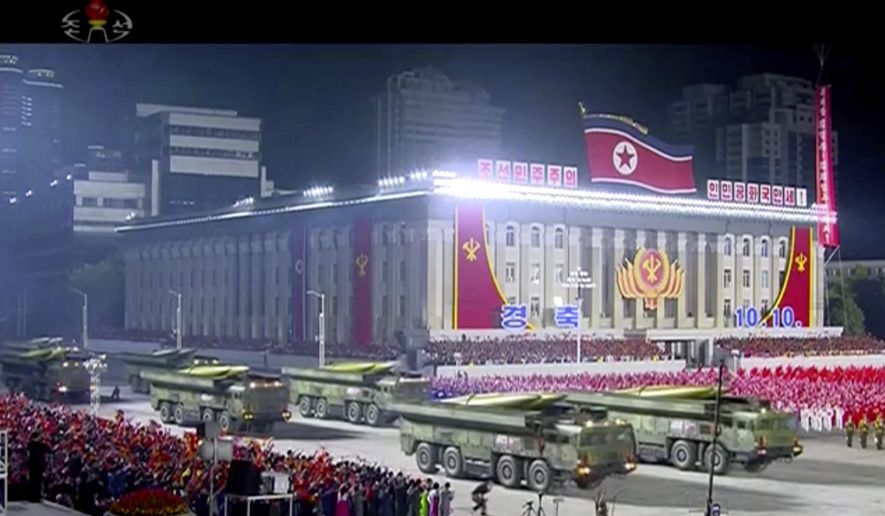North Korea’s communist regime on Saturday unveiled yet another intercontinental-range ballistic missile capable landing warheads in the United States, according to state media reports.
The new road-mobile ICBM had not been seen before and was displayed during a parade in North Korea on a transporter-erector launcher with 11 axles, two more than the KN-22 ICBM that was test fired in 2017.
The new missile is the fourth ICBM for the North Koreans, after the Taepodong, KN-20 and KN-22.
The parade in North Korea also showed the KN-20 and a submarine-launched ballistic missile called the KN-11.
The larger missile likely will have a longer-range than the KN-20 which has an estimated range of 7,000 miles.
A senior Trump administration official said the showing of the new ICBM called on the North Korean government to negotiate to achieve a complete denuclearization, Reuters reported.
“It is disappointing to see the DPRK continuing to prioritize its prohibited nuclear and ballistic missile program over working towards a brighter future for the North Korean people,” the official said, using the acronym for the country’s formal name, the Democratic People’s Republic of Korea.
North Korea’s ability to produce nuclear missiles shows international sanctions have not been effective.
The country has been under crippling international sanctions and a nuclear embargo following a series of provocative missiles tests, and abrogating a 1994 Agreed Framework that permitted the regime to import nuclear goods that were ultimately diverted to nuclear weapons.
A United Nations panel of experts reported several years ago that North Korea’s mobile missiles were built on transporter-erector launchers converted from Chinese lumber carrying vehicle covert exported in the early 2000s.
The display of missile force was the first since 2018 when North Korean leader Kim Jong Un began meeting with President Trump at two summits that sought to negotiate a denuclearization by the reclusive Kim regime.
Nuclear talks broke off after a failed summit between Mr. Trump and Mr. Kim in Hanoi in February 2019.
Video of the parade showed Mr. Kim giving a speech at midnight local time.
“We will continue to strengthen war deterrence for self-defense to deter, control and manage all dangerous attempts and threatening acts, including ever-growing nuclear threats, from hostile forces,” Mr. Kim said dressed in a light-gray suit, South Korea’s Yonhap news agency reported. North Korea uses the term “war deterrence” in referring to nuclear arms.
He also said North Korean military power would not be used preemptively.
“But should anyone undermine our national security and mobilize military power against us, I will retaliate by using the most powerful offensive force at our disposal and in a preemptive manner,” he said.
Analysts said the military show appears to have been have taken place earlier in the day and then broadcast using recorded footage.
South Korea’s joint chiefs of staff said the parade was staged at dawn and involved large numbers of weapons and troops.
North Korean long-range missiles have forced the Pentagon to re-evaluate its strategic missile defenses.
“I believe we have the capability today to deter North Korean aggression, but given where we think the North Korean capability might be in terms of their missiles in the next five years, I think we must continue to explore, improve, and resource our entire missile defense capabilities,” Adm. Philip Davidson, commander of the Pacific Command, said in 2018.
Upgraded defenses include Theater High-Altitude Area Defenses (THAAD) in Guam and South Korea, missile defense ships in the Pacific and near Japan.
“I support planned improvements to the [ballistic missile defense] of the homeland architecture via the new Homeland Defense Radar for Hawaii, additional purchase of Ground Based Interceptors, and a detailed study that ascertains the efficacy of positioning interceptors in Hawaii,” he said.
Adm. Davidson said he also wants to see improvements in the capabilities and numbers of ballistic and cruise missile interceptors that he said would “further enhance homeland defense capabilities and protect key regional nodes from North Korea’s aggressive action against the United States.”
Richard Fisher, a military affairs specialist with the International Assessment and Strategy Center, said the new missile appears to have the same diameter as the KN-22 “but is longer, to accommodate a new warhead bus and possible third stage.”
“The warhead bus is large enough to carry multiple warheads, but how many would depend on their size, something not clear from North Korean sources,” he said.
The new 22-wheeled ICBM launcher appears to be a variant of the Chinese 16-wheel transporters sold by China to North Korea in 2010.
“With 22 wheels this new ICBM has the largest mobile TEL in the world, exceeding the previous record of the HS-15’s 18-wheel TEL,” Mr. Fisher said.
“It is either made in China or assembled in North Korea with substantial Sanjiang Space Group/China Science and Industry Corp. assistance. It is safe to conclude this is yet another massive Chinese violation of the North Korea sanctions regime.”
• Bill Gertz can be reached at bgertz@washingtontimes.com.




Please read our comment policy before commenting.